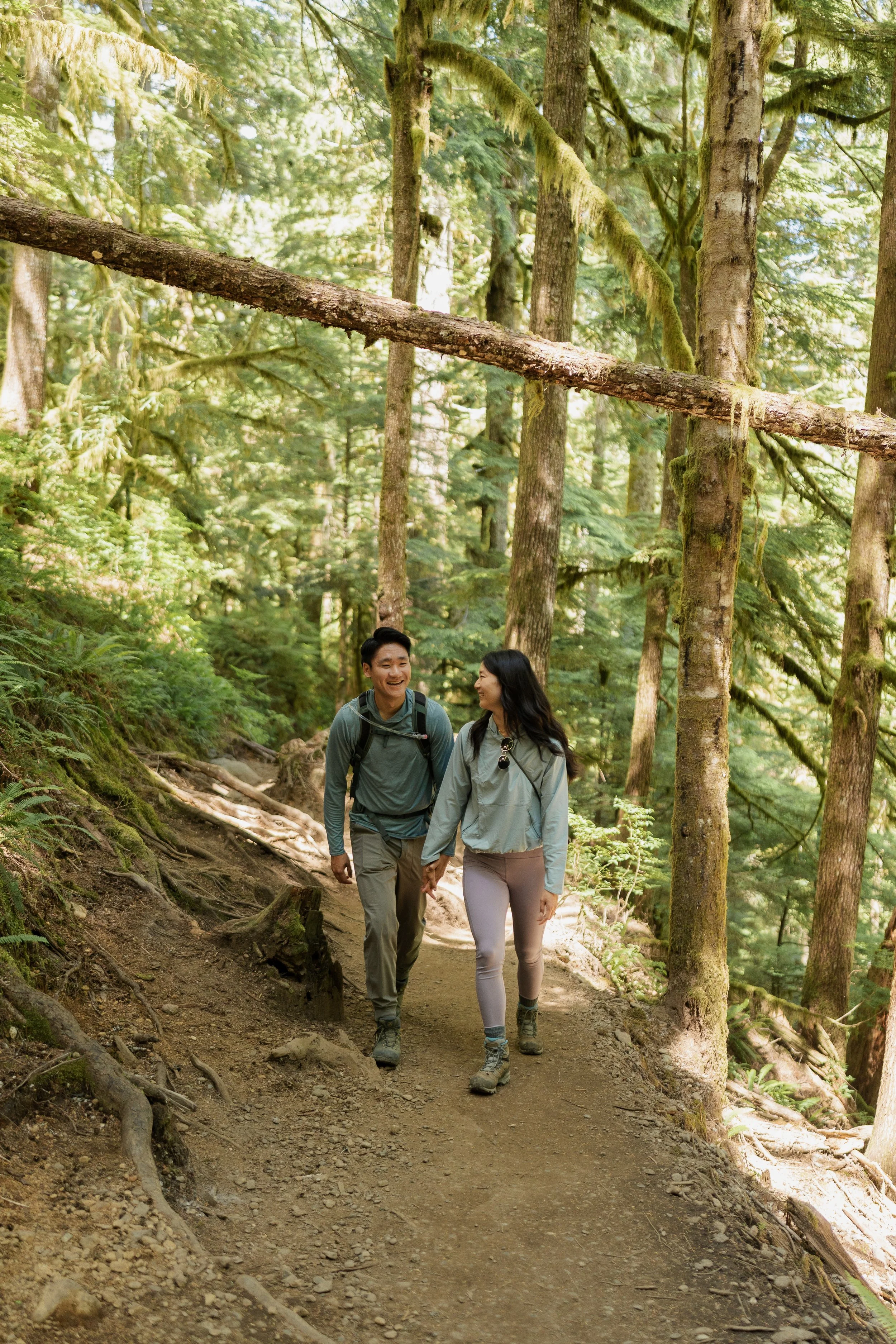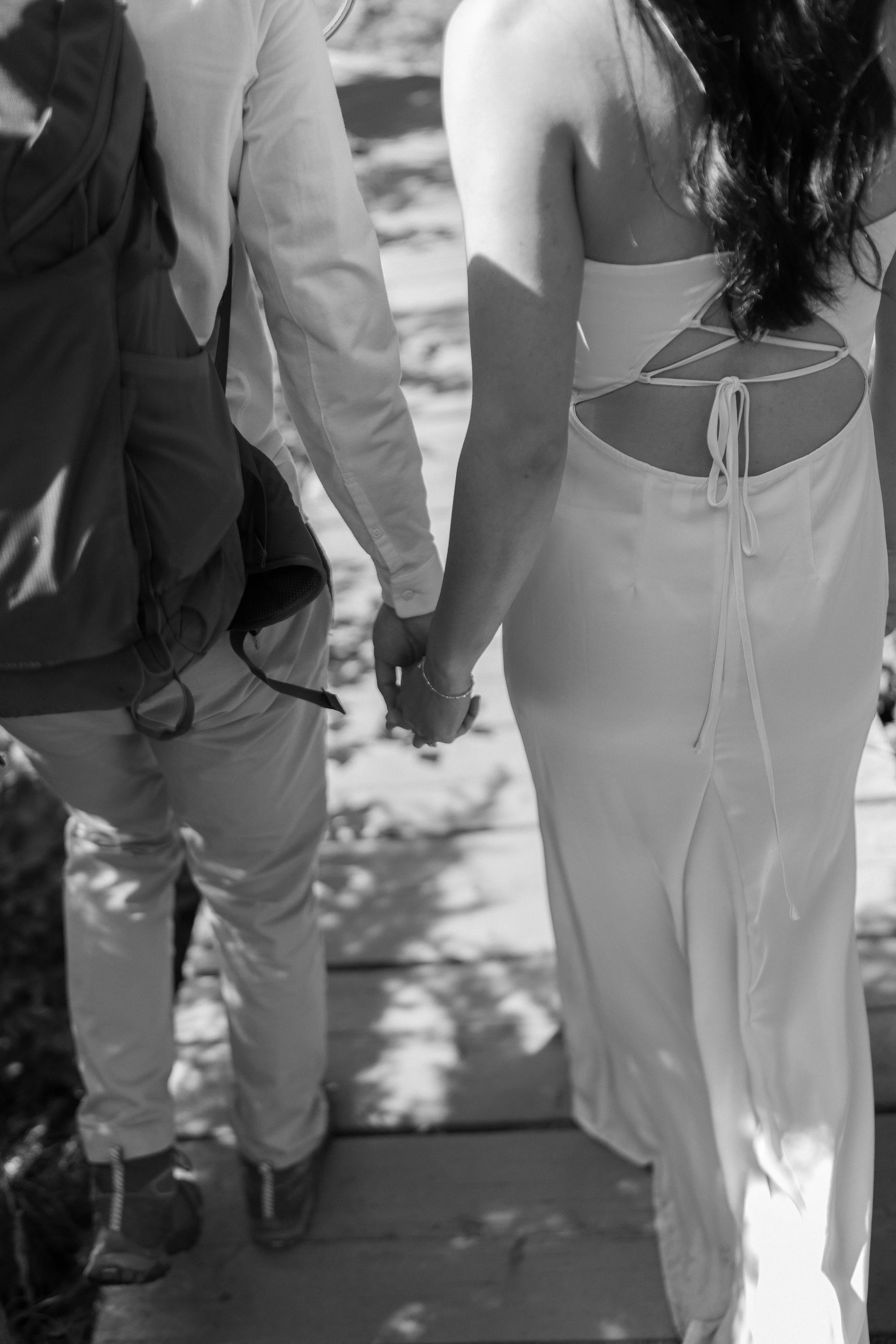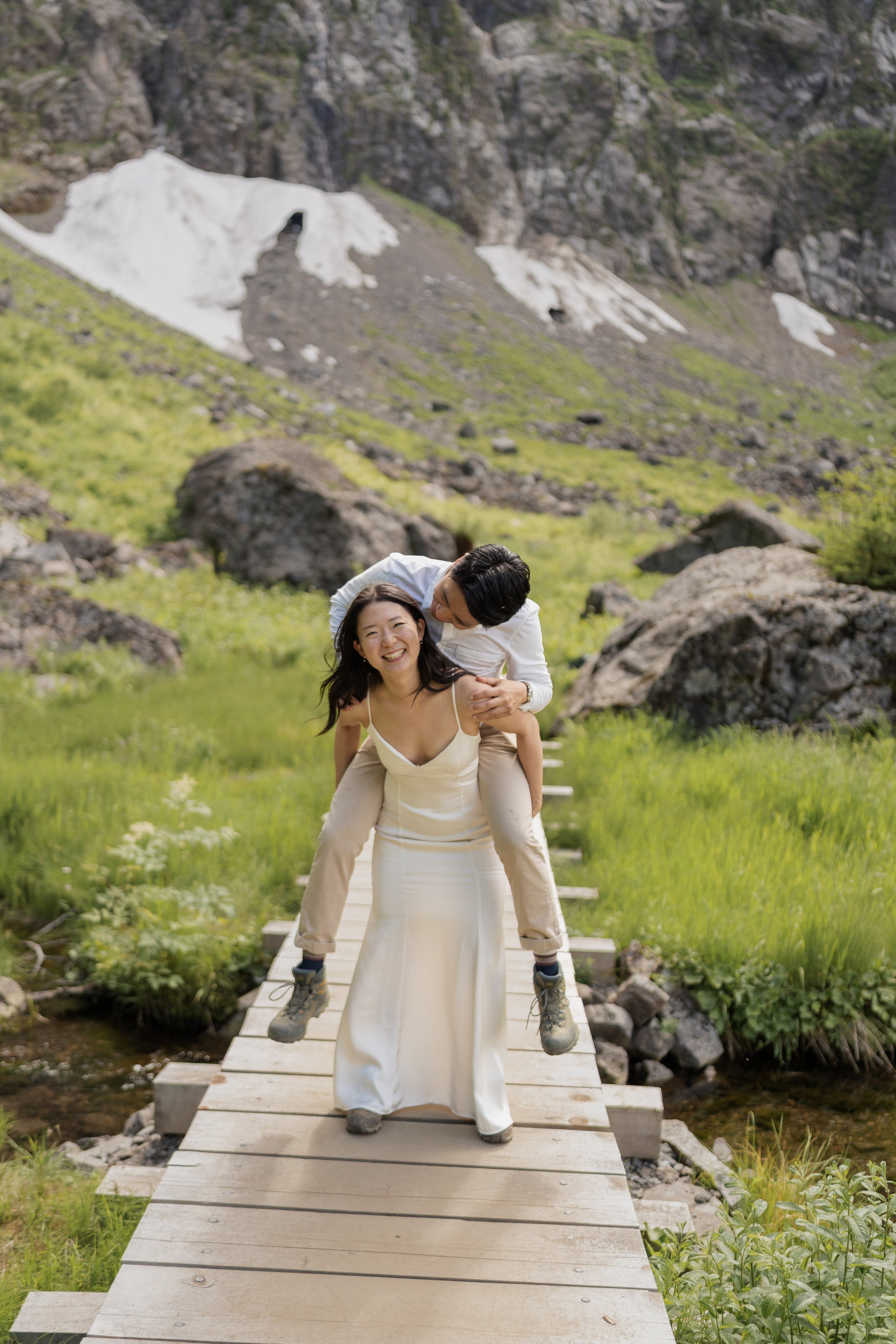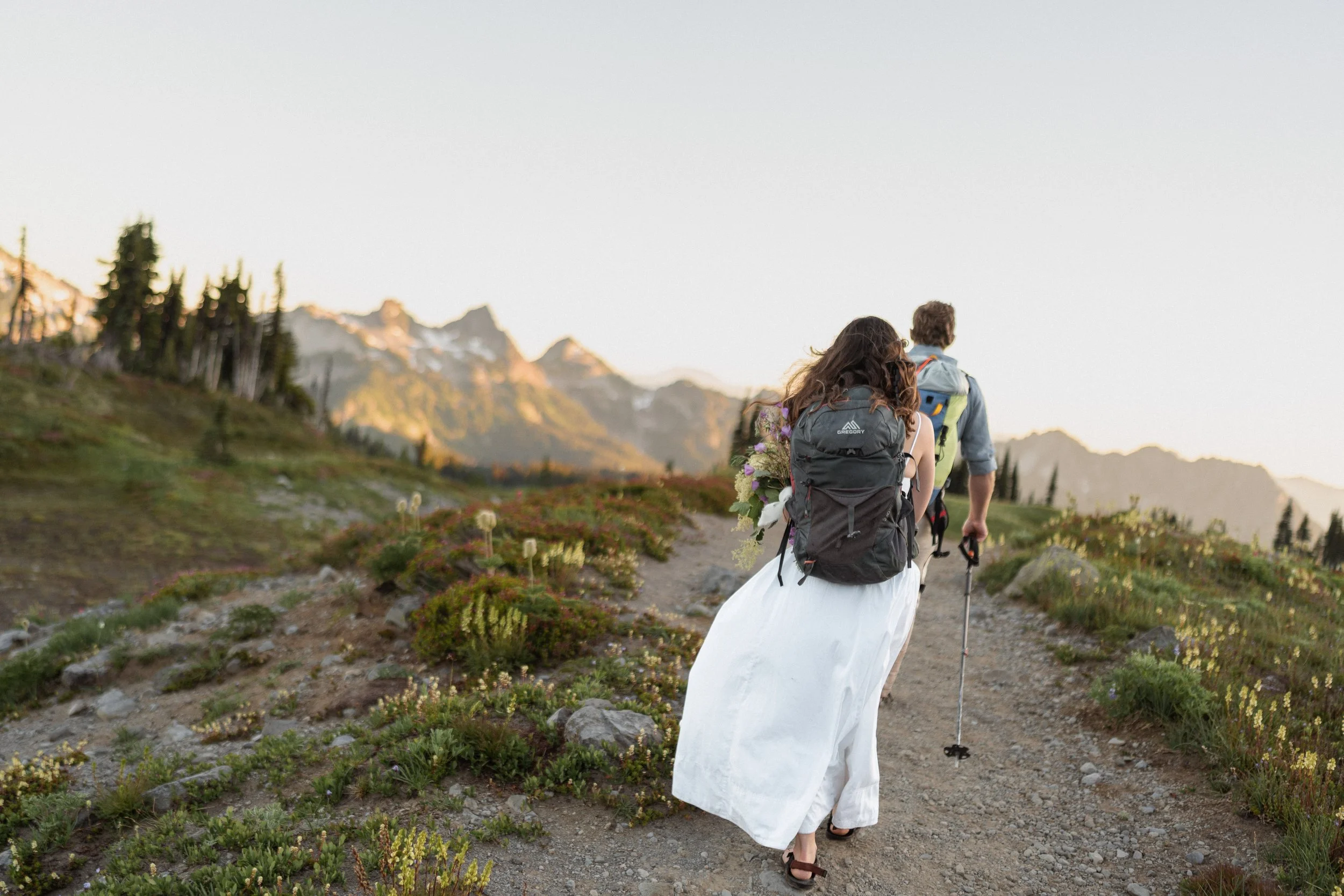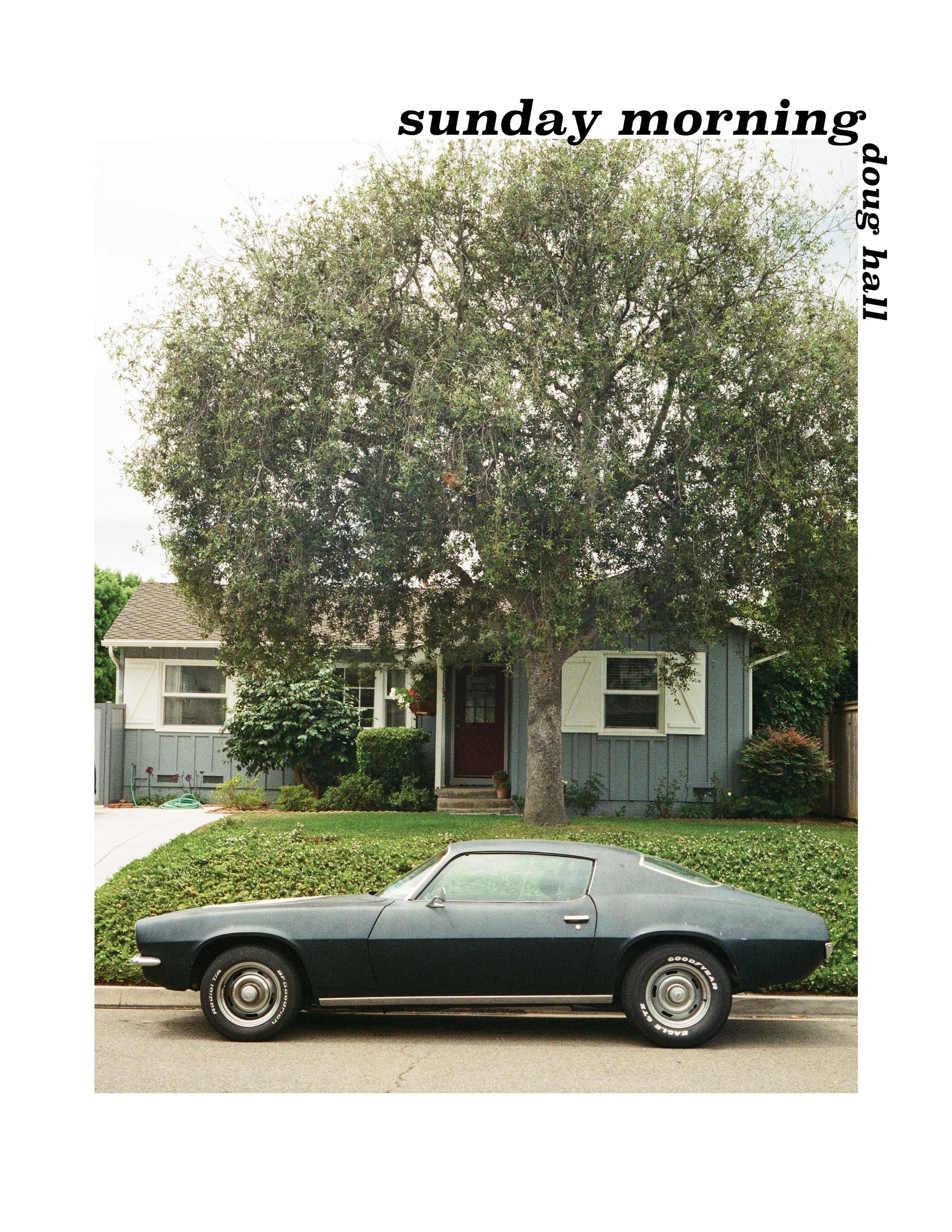An Engagement Session at Lake 22
If you’re dreaming of an adventurous engagement session in Washington, Lake 22 is one of the most breathtaking places you can choose. This alpine lake sits along the Mountain Loop Highway in the North Cascades, surrounded by old-growth forest, rugged cliffs, and crystal-clear water that reflects the mountains like a mirror.
The hike gains steady elevation, but you’re rewarded with lush greenery, dramatic forest views, creeks, and boardwalks along the way. When you reach the top, the trail opens up to a peaceful alpine lake with a loop trail that circles the shoreline. This loop is what makes it such a standout location for engagement sessions because the scenery changes every few minutes.
The North Cascades offer some of the most photogenic and diverse landscapes in Washington. Lake 22, in particular, is stunning for engagement photos because of its alpine lake, beautiful Evergreen forests and mountain-backdrop viewpoints. Photographing love in a place like this feels incredibly natural. The scenery is breathtaking and adds to the story in a way only the Pacific Northwest can.
One of my favorite parts of doing these sessions is the time spent hiking together. It creates space for conversation and connection, and by the time we reach the main photography location, everyone feels relaxed and comfortable. Not to mention, you usually get the most stunning views the PNW has to offer.
Once we reached the top, they did a quick outfit change and we took our time exploring the loop around the lake. Each section of the trail offered something different whether it be the winding trail tracing the lakeshore, the massive rocky peaks and stunning lakeshore.
Every few minutes, we’d stop to capture a new angle or lighting moment. This variety makes Lake 22 especially great for couples who want an adventurous gallery with lots of visual diversity.
After we finished shooting around the lake, we hiked down together as the forest shifted into soft evening light. It was the perfect, peaceful ending to a day filled with connection, conversation, and incredible scenery.
Some sessions stick with you because of the photos. Others stay with you because of the experience. This Lake 22 engagement session was both.
For this engagement session, I used a mix of film and digital to create a layered, artistic feel.
Film brings out the greens and shadows of the North Cascades beautifully, while digital allowed me to capture movement and quick candid moments. Together, they create a gallery that feels nostalgic, timeless, and true to the atmosphere of Lake 22.
If you’re thinking about booking your own engagement session at Lake 22 or elsewhere in the North Cascades, I’d love to help you plan something unforgettable.
Whether you want a sunrise adventure, a sunset hike, or a session that incorporates film photography, Lake 22 is truly one of Washington’s most beautiful locations for engagement photos.
An Unforgettable Elopement on Mt Rainier
Recently, I had the privilege of documenting one of the most extraordinary weddings I’ve ever photographed, an adventurous elopement perched on the side of Tahoma (Mount Rainier) in Washington. This day was a perfect blend of natural beauty, spontaneous wildlife encounters and intimate moments that only a true mountaintop ceremony could offer.
The day began with Tahoma wrapped in clouds, no sign of it showing face, typical of the mountain’s unpredictable weather. Just as we started our ascent, something magical happened, a break in the clouds allowed warm rays of sunshine to pierce through, bathing the trail in golden light. It was as if nature itself was celebrating the beginning of this new chapter in their lives.
The hike was no small feat. At one point, we found ourselves crossing a thigh-high river, carefully balancing and wading through the icy water with my camera gear in hand. Every step was deliberate, each moment a blend of thrill and focus, reminding me of the couple’s journey: navigating life’s unpredictable terrain together with resilience and trust.
The mountain’s wilderness greeted us with lively surprises. We were fortunate enough to see over 40 mountain goats throughout the day. peacefully grazing along the slopes, a true sign of the mountain’s wild, untouched character. Watching these sure-footed creatures navigating the rocky terrain added an awe-inspiring element to the day, emphasizing the sense of adventure and the wilderness that surrounded us. Utilizing one of the goat paths we moved along a grassy and flower filled ridge that would be at the base of where we would need to climb up.
We reached a secluded ridge overlooking the expansive mountain vista. It was a perfect spot: remote, breathtaking, and free from any distractions or crowds. Only the couple’s closest friends and I were present to witness their vows, surrounded by the pristine beauty of Tahoma’s rugged landscape, alpine wildflowers, and expansive skies. The quiet serenity of this spot created a sacred space where love felt amplified by the natural surroundings.
Before we ascended to their final ceremony spot, the groom took a moment of his own to prepare the bouquet, tying a small piece of ribbon. Holding them in hand as we made our way up to the ridge. Despite the rugged conditions, they were barefoot, feeling the connection with the earth beneath their feet. With the bouquet in hand and a calm, focused expression, we approached the final spot of the ceremony, standing at the edge of the ridge, surrounded by nothing but the endless sky, towering peaks, and wildflowers. These quiet, sacred moments on the verge speaking the most heartfelt vows made the day oh-so special.
The ceremony itself was heartfelt and genuine, filled with smiles, tears, and the quiet backdrop of the wind and distant mountain echo. With an unobstructed view of the mountain’s grandeur, the couple exchanged vows that reflected their bond and commitment, an intimate moment forever etched into the landscape.
Throughout the day, I used a combination of film and digital photography to capture this extraordinary day. I shot with both 35mm and medium format film, aiming to preserve the timeless, soulful quality of the moment. The film’s organic textures and rich tones complemented the stunning scenery, while my Sony A7IV ensured I could document every spontaneous detail, the delicate expressions, and the sweeping vistas with clarity and precision. Blending the old with the new allowed me to tell the story of this day from multiple perspectives, creating images that are both nostalgic and vibrant.
This elopement was more than just a wedding, it was an adventure of discovery, love and connection with nature. It encapsulated the spirit of exploration and the courage to embrace the wild unknown, both in the landscape and in a life commitment of love. The experience reminded me that some moments are so profound that they require nothing more than the vastness of the mountains and the sincerity of two hearts coming together.
As I reflect on this day, I am reminded that sometimes, the most meaningful stories unfold away from the crowds, in the quiet corners of the world where nature is the ultimate witness. It was an honor to be part of this breathtaking journey, capturing memories that will last a lifetime amid the majestic clouds and Tahoma’s extraordinary landscape.
If you’re looking to elope at Mt Rainier I would love to connect with you on documenting your big day, you can find my current rates and offerings on my wedding and elopement packages under the weddings tab at the top of the page or click here!
DISPATCH 004 - Shooting Street in the Emerald City
Street photography has always been something I’ve admired, seeing the perspective a photographer has in their own city is documentation like no other. Cities constantly change and evolve and documenting that process is something I’ve had my eyes set on ever since moving to Seattle. Standing on a corner for hours, observing patterns and seeing people go about their day, whether it’s the daily commuter or tourists trying to take it all in, there’s always something new.
This past year I got into throwing Paulie B’s YouTube videos (link here) while I develop, scan and post process my work. If you haven’t checked out his channel and are interested in street photography or want to hear insights from photographers around NYC documenting their city I would jump on it, it’s given me the most inspiration behind dipping my toes into street work.
With all the motivation I’ve been starting to set aside a couple days a week to document downtown Seattle. I have a feeling 2024 will be filled with more street work than exploring Seattle’s neighborhoods as I aim to show how important it is for me to show Seattle through my lens. Walking the streets with my medium format cameras I found I was missing a lot of photos I wish I could have created, making myself carry the F3 and just the F3 has been a choice I’m glad I made as capturing what I see is so much more streamlined.
Enjoy the following images, these are from my first few rolls of 2024 dipping my toes into street photography around Seattle.
That wraps up my first few rolls into street work here in Seattle, something that you’ll be seeing a lot more of in 2024.
Let me know in the comments below what your favorite camera/film combo is for street work and check out my links below for all the gear I use weekly for post processing my work!
Gear Used:
Camera - Nikon F3
Lens - 28mm f2.8
Film Used: Kodak Portra 800, Kodak Tri-X 400, Cinestill BwXX
Portfolio: www.douglasrhall.com
Amazon Link - Developing & Scanning Gear
Other Dev & Scan Gear - Negative Supply
Track Club - Music Licensing Tool
DISPATCH 003 - Seattle on Kodak Tri-X 400
Starting the year off with a handful of rolls on a nearly 10 mile walk around downtown Seattle was a bold choice. Living in downtown has given me the freedom of being immersed in a creative zone, you’ll never find me without a camera when I leave the house. From busy city streets to the tightly packed neighborhoods surrounding the center of downtown, there is always something to shoot with this ever-changing city. If you haven’t visited Seattle, it’s hilly, wet and full of diversity. Each corner of the city offers something different, something that’s always suited by black and white. Sure, the color green is abundant and who doesn’t love some good greens? Although color is beautiful in this city, I’ve always felt the true grunge of the PNW shines through with black and white film.
A recent favorite film stock of mine being Kodak Tri-X 400. A 400 speed black and white negative film stock that’s been a staple in Kodak’s offering for over 65 years. Tri-X is something that I didn’t shoot much of before a recent pro pack landed on my doorstep, in fact I had only ever shot it once before these rolls. Being that I’ve had an itch to shoot more and more black and white I’ve had a focus on finding a different workflow from my choice of film to my developing chemicals (check out the current developing chemicals I’ve gone with for black and white, I made a big change up with using Kodak chemicals across the board- here). Now, I’m not going to spew technical information about Tri-X 400 but what I will say is it seems to suit just about every situation I threw at it and Seattle can be a bear to meter light in.
That’s enough words, enjoy some of the first photos I’ve made this year, I can’t wait to keep exploring this gorgeous world through black and white photography.
Location: Seattle, WA
Camera/Lens Used: Mamiya RZ67 Pro / 110 f.8
Film Used: Kodak Tri-X 400 - buy here
Chemicals Used: Kodak D-76, Kodak Kodafix, Kodak Photo-Flo - buy here
Scanned using Negative Supply gear and converted using Negative Lab Pro
I hope you enjoyed this little gallery and I hope it has sparked a desire to keep black and white in your bag more often. It’s something I’m striving to do more of this year, the learning experience with mixing it into your work is such a great way to develop other approaches to composition without relying solely on color.
Be sure to check out the links below to grab yourself some film and to keep up with some of my favorite products that I use to create my work. Till next time!
DISPATCH 002 - Seattle in Black and White
Most of my work consists of color, using color to balance images and create compositions can be such a fun way to shoot. One of my favorite things to do is to use opposing colors to help capture and create the mood I want in a scene. What’s a better way to capture the moody essence of a particular scene than to shoot it in black and white?
Aside from the obvious factor of a black and white image relying on composing based on subjects, I find that black and white captures the true documentation of highlighting subjects without the distraction of color. I’ve found that color still plays a roll in how you can use light to help tell stories, getting different gradients of grays, using different angles to change how the subject is viewed and metering for areas I generally wouldn’t so I can gain more contrasty and dramatic images.
The following images were created in Seattle, shooting black and white is my favorite way to document here. Getting to capture a city with as much character as Seattle has been calling my name for quite a while now, it’s easy to be addicted to the vibrant greens and constant season shifts but black and white just always feels good here. You will definitely see more black and white incorporated into my portfolio for the coming months.
Enjoy.
Camera: Mamiya RZ67 Pro | 110 f2.8
Film: Cinestill BwXX, Ilford Delta 100
Developer: Cinestill Df96
Scanning Equipment: Negative Supply
Cinestill BwXX
Ilford Delta 100
I hope you enjoyed scrolling through these as much as I did shooting and revisiting them, black and white will be a more frequent thing as we go through winter here in Seattle. I find shooting black and white fine tunes the process of composing based on subjects and it continues to teach me every time I load it.
Direct links to the film, developer and gear I use for developing black and white film at home. Cheers!
DISPATCH 001 - Sahale Arm, North Cascades National Park
The start to a long awaited series highlighting photosets I create. From local neighborhoods to the tops of the glacial mountains, the dispatch series will allow you to see life through my eyes. Nothing will follow a pattern as my styles and subjects are constantly changing in an effort to become a dynamic photographer. I hope you all enjoy the series as much as I do getting to create these images!
It’s still mind boggling that I can live in a city as bustling as Seattle but have the ability to reach areas such as the North Cascades within a few hours. Growing up in Southern California, a bragging point was always the access to just about every environment within hours, until I got to Seattle. That’s when I realized that there are a plethora of mountains hiding behind the almost always cloudy skies. Not just mountains, but some of the most beautiful peaks in the entirety of North America. With options everywhere and not having explored much of these breathtaking places, I got an invite to scramble up Sahale Arm in the North Cascades.
A nearly 12 mile round-trip trail, hitting almost 4000ft of elevation gain, this was a bold way to step back into hiking. Being that the past year in Seattle I had nearly converted myself to a pure street photographer this hike brought back a love for landscape photography that had been laying dormant since the beginning of my exploration into photography.
The following images were captured on 120 and 35mm film, lugging my Mamiya RZ67 Pro, Nikon F3HP and Olympus Stylus with a myriad of film stocks.
Enjoy.
See below for a link to my storefront on Amazon, purchasing through my link helps me able to keep sharing and creating! You can find anything from my favorite film I buy to all of the developing and scanning gear i reccommend. Thank you!
I'm Back. Film Photography Update.
Hey friends!
I’m back, for real this time. The past few years I’ve been pretty absent from my blog writing on my website. Starting from outdoor and overland gear reviews, curving towards my restart with digital photography and most recently dipping my toes into film photography. Now we are married to the medium of analog photography. With a career change and new path I have a lot to throw down here but we will keep it brief for this re-intro to my life in words.
Pentax 67 x Kodak Gold 200. Shot in Seattle, WA.
If you’ve followed along in the past you’ll know I’ve dabbled into every aspect of digital photography until I hit a burn out and a loss for creative expression through photography. With my change to film I have been immersed further into my work than ever before and am not looking back. I have nothing against digital photography and will eventually make my way back to including it in my work flow but film has helped me refine every aspect of my photography.
From slowing down the process it’s allowed me to show focus on areas that I’ve wanted to improve on for a long time. From my compositions in camera, awareness of lighting and patience with post processing it has helped me improve and streamline my work. Film has brought in a better understanding of light, where it be certain times of day, types of artificial light or utilizing better angles when it comes to shooting with harsh or cinematic light. The other side of film that I have absolutely loved is how welcoming the community has been and how supportive it can be. This is where the new career path starts.
Fuji GA645 x Kodak Gold 200. Shot in Seattle, WA at T-Mobile Park.
Canister Club. Canister Club is an idea that I have formulated while falling in love with film photography. At the moment Canister Club exists as a spot to find used film cameras and accessories on Etsy, with Instagram as the primary social media platform to build our community, I have plans to expand Canister Club into a storefront focusing on also creating a creative space for local and visiting photographers. This plan will be rolling out in steps, stay tuned and follow our Instagram to keep up with our journey. Check the bottom of this post for links.
Pentax 67 x Kodak Portra 800
With the change in career I have also started lining up more clientele work, focusing on portraiture and branding all on film. Using a mix of medium format with my Pentax 67 and 35mm with my Nikon F2 it’s an absolute blast using cameras stuck in the 70’s. My goal is to keep ramping this work up to keep expanding my portfolio and experience of shooting commercial work on film. There are multiple projects on my mind, one is to publish my second zine and the other is to be active in this space.
My goal is to keep my blog current and up to date with valuable information on my photo projects, weekly photo walks and reviews on film cameras and gear that I use. Drop some suggestions on anything you are looking forward to seeing me post about and I would be stoked to share my knowledge!
If you’re still here, thank you for taking the time to read through, this blog will retain more information and images that aren’t shared to my social media platforms. I will be back soon with an update on some of the current cameras I am using for my own projects.
Nikon F2 x Kodak Gold 200. Seattle, WA on the way to Bainbridge Island.
Cheers! Happy Shooting!
First Zine: sunday morning - UPDATE
UPDATE: Sales Closed
Sunday Morning is comprised of images inspired by regular Sunday morning drives. All located in Orange County, these are the roads I frequent. Shot entirely on 35mm and 120 medium format film during 2022.
Focusing much more on film photography over the past year has definitely opened my eyes to how much of the world is really available to shoot. Everyday scenes have become intriguing, exploring neighborhoods in my local area of Costa Mesa and Newport Beach has given me light to how photographic your everyday life can be.
I’m excited to release my first zine, for those of you not familiar with a zine, these are are smaller books that are more simple than creating a larger book. It is 30 pages long and 26 images, printed on 8.25 x 10.75” pages. I will only be selling 50 copies. Unfortunately, shipping is a bit pricey. If you are overseas shoot me a message on social media or over email and we can figure something out.
Cheers.
The Canon AE-1 35mm Film Camera
Well, the first part of my gear review begins.
Bringing you, the Canon AE-1. One of my favorites and the first film camera I bought, this thing is a workhorse. Being probably the most popular 35mm film camera out there, this thing screams that vintage film camera aesthetic. Which is definitely not the reason I picked it up, ok maybe it is.
There isn’t any set feature of this camera that I especially love but it just works. Paired up with a 50mm f1.8 lens, I haven’t found myself in need of any other glass yet. However, if you do want to pick up another focal length there are plenty out there, this camera uses the FD mount. It won’t allow you to mount any EF glass but luckily FD glass isn’t too astronomically priced.
I wanted to list a few features of the camera, nothing is too exciting but I figured you’d rather have the info present:
1/1000 shutter speed max, down to bulb mode
Light meter built into the viewfinder.
Needle style, you choose your shutter speed and it’ll give you the aperture to select.
ASA/ISO selector for whichever film you are using is within the shutter selector.
Goes from 25 all the way up to 3200.
Hot-shoe mount on top.
I haven’t used mine with a flash so I can’t say much more.
Film cardboard piece holder on the back
If you’ve never shot film this helps you remember what film you have inside the camera.
I haven’t found any complaints about the camera as I’ve experienced no issues with it. I did notice that with my girlfriends Canon AE-1 Program that the viewfinder is much clearer and a better experience when focusing as well as some other features present in the AE-1 Program that my regular AE-1 doesn’t have. I’ll write a review on that camera as well in the future. Other than that I wouldn’t say anything about the camera limits me from telling you to just buy it. It’s a camera that I will never get rid of and I cannot wait to try some different glass that I’ve been recommended for it. Stay tuned for more reviews involving FD lenses I gather for the AE-1.
Below is a link to purchase your very own Canon AE-1 on Amazon as well as my two favorite films to shoot, this link helps keep me posting and helps keep me shooting. Any and all support helps, below the ads are some images that I captured with my AE-1, all are also available for print, just ask.
Canon AE-1 // Kodak Portra 400
Canon AE-1 // Kodak Portra 400
Canon AE-1 // Kodak Portra 400
Canon AE-1 // Kodak Portra 400
Canon AE-1 // Ilford HP5 Plus 400
Canon AE-1 // Portra 400
Peace
Film.
It’s been a while, I know.
Work life, personal life and my per-usual flipflop between hobbies. The past couple years have been inconsistent with shooting, however, during covid I of course scooped up all of my camera gear again and got back after it. Trying to focus more on what I wanted to shoot and not what would get me paid, it helped me explore a more artistic value to my work.
Mamiya RB67 Pro S // Fuji Pro 400H
In the past, my photography has always maintained a very technical side. When learning to shoot I solely relied on hours of YouTube and trial and error. Leaving little room to explore and just let myself enjoy the artistic aspect of photography, I got swallowed up in the technical abilities of the cameras I was using. I’m not all that mad that I never honed in an artistic eye towards the start of my work, it taught me to use the camera and experiment with what it could handle and I never grew up exploring my artistic side, it was always focused on athletics. Not that any of this is super relevant to anything I’m about to talk about but I thought I should fill you all in on what I’ve been up to in regards to photography and kind of where I started at to help understand why I’ve spent so much time recently behind the camera, with a whole different approach, film.
Yes, I’ve gone from overly expensive new cameras to older, more expensive cameras. Now, getting to explore cameras and how they work with digital is great because you get instant feedback as to if you successfully exposed an image or nailed your focus. But, there is something to say about shooting film and the coloring being irreplaceable. The way the colors blend together is something that digital can’t replicate, sorry, you just can’t.
Mamiya RB67 Pro S // Kodak Portra 400
Film the past year has mostly been using my Canon AE-1 as well as a Minolta X700 that I picked up shortly after. Two cameras can be fun, especially when you’re learning. When shooting digital you can edit your photo however you please, you can choose to have your photo end up black and white or remain color. With film, that decision is made when you load your film, I prefer carrying two 35mm cameras so I have that ability to switch between the two. When I decided that film would be a primary focus of my work I decided to jump into the world of medium format.
Not knowing what would fit my needs and budget the most, I took to my YouTube research. Finding a handful of medium format cameras on eBay, I finally took a stab and grabbed a Mamiya RB67 Pro S. Most of these were located in Japan and not wanting to have that large of a camera ship overseas, I found one located in California so I knew it had the least chance of showing up damaged. Nervous as always with film, I loaded my first roll immediately, Portra 400 of course, and hit The Circle in Orange. Getting to shoot only 10 images per roll it definitely forces you to take your time and compose and be patient.
Mamiya RB67 Pro S // Kodak Portra 400
After getting the first roll back from the lab I realized I already needed to spend some money, just about half the roll was just slightly out of focus. The camera came with a film back for 220 film, that’s right, they don’t make 220 film any longer. 220 film does not have the paper backing (from my understanding) that 120 does so putting 120 film into a 220 film back can cause a different focusing distance, I’m sure it’s almost immeasurable. Using 120 film, which is the current medium format size film available, can also cause extra stress in the 220 film back. Although they don’t make 220 film any longer you can still find expired rolls on eBay pretty often and most film labs will still develop it so it might be a good idea to keep it intact. The following images are from another couple rolls I shot with the Mamiya, it’s been an absolute blast to shoot.
With all this shooting the past year it’s made my style come much more to life. I have never felt more satisfied about my work at the moment, it’s brought my passion for photography back around. With multiple ideas for current projects I am shooting more than ever, keep an eye out for a zine or photo book as I will be releasing something soon that I am very excited about. In future posts, this blog will help give you a better look at the gear I am using, the techniques I utilize and places I enjoy shooting. Enjoy a few more shots below.
Be back soon.
Canon AE-1 // Kodak Portra 400
Mamiya RB67 Pro S // Kodak Portra 800 (expired)
Mamiya RB67 Pro S // Kodak Portra 800 (expired)
Olympus XA2 // Fuji Superia 400
Canon Canonet ql17 giii // Fuji Superia 400
Canon Canonet ql17 giii // Fuji Superia 400
Canon Canonet ql17 giii // Fuji Superia 400



